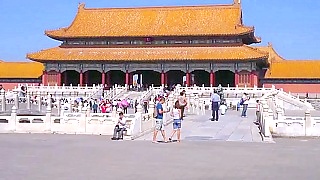
|
1. 1.4 billion - China's population, making it the most populous country in the world.
2. 23 - The number of provinces in China.
3. 56 - The number of recognized ethnic groups in China.
4. 9,596,960 square kilometers - China's total land area.
5. 1949 - The year the People's Republic of China was founded.
6. 70 - The percentage of the world's total silk production that comes from China.
7. 2,000 - The approximate number of years the Great Wall of China has been in existence.
8. 1971 - The year when China was admitted to the United Nations.
9. 34 - The number of UNESCO World Heritage Sites in China.
10. 4,000 - The years of recorded history in China.
11. 3.7 million square kilometers - The area covered by China's desert, the Gobi Desert.
12. 88 - The number considered lucky in Chinese culture.
13. 40,000 - The length of China's high-speed railway network in kilometers.
14. 1.4 trillion - The approximate number of disposable chopsticks used in China each year.
15. 4 - The number of official Chinese characters on the national flag.
16. 2nd - China's rank in the world for the largest economy.
17. 2008 - The year Beijing hosted the Summer Olympics.
18. 7 - The number of consecutive years China has been the world's largest exporter.
19. 1.4 billion - The number of mobile phone users in China.
20. 60 million - The approximate number of empty homes in China.
21. 40,000 - The approximate number of characters in the Chinese language.
22. 1,411 meters - The height of the Shanghai Tower, the second-tallest building in the world.
23. 8.98 million - The size, in square kilometers, of the Tibetan Plateau, often called the "Roof of the World."
24. 800 million - The number of internet users in China.
25. 50,000 - The number of rivers in China, each with a basin exceeding 100 square kilometers.
26. 300 million - The number of Chinese people practicing Buddhism.
27. 20 million - The number of Chinese Muslims.
28. 64 - The average life expectancy in China.
29. 45 - The percentage of China's population living in urban areas.
30. 1.39 billion - The number of active social media users in China.
31. 7,546 - The length, in kilometers, of the Grand Canal, the world's longest artificial waterway.
32. 15 million - The number of babies born in China each year.
33. 37 - The number of UNESCO Intangible Cultural Heritage items in China.
34. 2003 - The year China became the third country to launch a manned space mission.
35. 2.3 million - The size, in square kilometers, of the Taklamakan Desert, China's largest desert.
36. 12,000 - The number of terracotta warriors buried with China's first emperor, Qin Shi Huang.
37. 520 - A term in Chinese internet culture representing "I love you."
38. 100 million - The number of tourists who visit the Great Wall of China annually.
39. 2 - The number of pandas given as gifts by China to foreign countries as goodwill ambassadors.
40. 65 - The percentage of the world's total production of solar panels that comes from China.
41. 2,300 - The length, in kilometers, of the Yangtze River, China's longest river.
42. 1 - The number of children per couple allowed under China's one-child policy (recently replaced by a two-child policy).
43. 7 - The number of Chinese astronauts who have been in space.
44. 200 million - The number of bicycles in China.
45. 5,000 - The number of years tea has been consumed in China.
46. 300 - The number of TV channels in China.
47. 1.1 billion - The number of Chinese people who watch the annual CCTV Spring Festival Gala.
48. 221 BC - The year Qin Shi Huang unified China and became the first emperor.
49. 4 million - The number of college graduates in China each year.
50. 5 - The number of autonomous regions in China.
51. 3,300 - The length, in kilometers, of the Yellow River, China's second-longest river.
52. 49 - The percentage of the world's total coal consumption that comes from China.
53. 16,000 - The length, in kilometers, of the Great Wall of China, including all of its branches.
54. 1949 - The year when the Chinese currency, the Renminbi (RMB), was introduced.
55. 2.5 million - The number of electric vehicles sold in China in 2020.
56. 2,200 - The length, in kilometers, of the Mekong River, which originates in China.
57. 22 - The number of provinces, regions, and municipalities directly under the central government.
58. 150 million - The number of square meters of new construction added daily in China.
59. 8,848 meters - The height of Mount Everest, which straddles the border between China and Nepal.
60. 1966-1976 - The years of the Cultural Revolution in China.
61. 80 - The percentage of the world's total rare earth elements produced by China.
62. 8 - The number of major Chinese cuisines, including Sichuan, Cantonese, and Shandong.
63. 1.4 billion - The number of people covered by China's national health insurance.
64. 2 - The number of sessions of the National People's Congress held each year.
65. 1980 - The year China implemented its one-child policy.
66. 7 - The number of national holidays in China.
67. 80 million - The number of people who visit the Forbidden City in Beijing annually.
68. 5 trillion - The total value, in U.S. dollars, of China's foreign exchange reserves.
69. 1,417 meters - The depth of the South China Sea, China's marginal sea.
70. 10 - The number of Renminbi (RMB) denominations, including the yuan and jiao.
71. 26 million - The number of university students in China.
72. 9 - The number of dragon's pearls on the Chinese national flag.
73. 1,100 - The number of Giant Pandas remaining in the wild.
74. 25 - The percentage of the world's total steel production that comes from China.
75. 3,300 - The number of characters in a standard Chinese dictionary.
76. 1978 - The year China began economic reforms under Deng Xiaoping.
77. 2 million - The number of people employed in the Chinese military, the largest in the world.
78. 40 - The percentage of global e-commerce transactions that take place in China.
79. 7.6 million - The length, in kilometers, of China's highway system.
80. 35 - The percentage of the world's total cotton production that comes from China.
81. 700 million - The number of Chinese people lifted out of poverty since economic reforms began.
82. 9,144 kilometers - The length of China's land borders.
83. 600 BC - The approximate date of the earliest recorded Chinese characters.
84. 10 - The number of years it took to build the Bird's Nest Stadium for the 2008 Olympics.
85. 20 - The percentage of the world's total energy consumption that comes from China.
86. 1971 - The year when ping pong diplomacy improved relations between China and the United States.
87. 2 - The number of pandas sent to the U.S. as a result of ping pong diplomacy.
88. 70 - The percentage of the world's total solar water heater capacity installed in China.
89. 2,213 meters - The height of Mount Lushan, China's most famous mountain.
90. 200 million - The number of Chinese tourists who travel abroad each year.
91. 1969 - The year China successfully tested its first nuclear bomb.
92. 2,000 - The number of years the Chinese have been drinking tea.
93. 4 million - The number of square kilometers of arable land in China.
94. 10 million - The number of university graduates in China each year.
95. 120 - The number of years the Qing Dynasty ruled China (1644-1912).
96. 30 - The number of world heritage sites in China.
97. 100 - The percentage of electric buses in Shenzhen, the first city in the world to achieve this.
98. 1949 - The year China adopted the "five-star" national flag.
99. 70 million - The number of Chinese households that play Mahjong regularly.
100. 80 - The percentage of global Bitcoin mining that takes place in China.
|
 Something different – music – RUMI
Something different – music – RUMI






